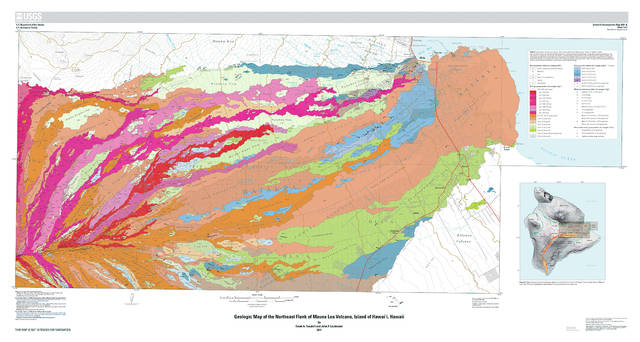Volcano Watch: New map reveals geologic history of Mauna Loa Volcano’s northeast flank

The new “Geologic map of the northeast flank of Mauna Loa volcano, Island of Hawai‘i,” the culmination of many years of work by Hawaiian Volcano Observatory geologists, was recently published by the U.S. Geological Survey. The work was spearheaded by John P. Lockwood (affectionately known as “Mr. Mauna Loa”), who is now retired from USGS and HVO, and Frank Trusdell, HVO’s current Mauna Loa Project geologist.
ADVERTISING
For the northeast region of Mauna Loa, this updated map supersedes the “Geologic Map of the Island of Hawai‘i” (1996) and the “Geologic Map of the State of Hawai‘i” (2007).
Encompassing 440 square miles (1,140 sq km) of the northeast flank of Mauna Loa, the new map comprises an area equivalent to the islands of Moloka‘i and Lana‘i combined. The mapped area extends from an elevation of 10,880 feet (3,316 m) to sea level, from Pu‘u‘ula‘ula (“Red Hill”) on the southwest to Hilo on the northeast.
Mauna Loa, the largest active volcano on Earth, is known to have erupted 33 times since written descriptions became available in 1832. Some eruptions were preceded by only brief seismic unrest, while others followed several months to a year of increased seismicity. Since 1832, seven eruptions occurred within the area covered by the map: 1852, 1855-56, 1880-81, 1899, 1935-36, 1942 and 1984.
The Northeast Rift Zone of Mauna Loa is about 25 miles (40 km) long and 1.2 to 2.5 miles (2 to 4 km) wide. It narrows at Moku‘aweoweo, the volcano’s summit caldera, but becomes diffuse (3.4-4.3 miles, or 6-7 km, wide) down rift near Pu‘umaka‘ala Cone, about 7.4 miles (12 km) west of Mountain View. The rift zone is marked by low spatter ramparts and spatter cones as high as 197 ft (60 m).
Eruptive fissures and ground cracks cut volcanic deposits and flows in and near the crest of the rift zone. Lava typically flows from the NERZ to the north, east or south, depending on vent location relative to the rift crest. For instance, during the 1880-81 eruption of Mauna Loa, flows initially traveled south toward Kilauea, but later, northeast toward Hilo.
Although most of the NERZ source vents are more than 19 miles (30 km) from Hilo, one branch of the 1880-81 flow nearly reached Hilo Bay. In fact, Hilo is built entirely on lava flows erupted from the NERZ, most of them older than 1852.
The map shows the distribution of 105 eruptive units (flows) — separated into 15 age groups ranging from more than 30,000 years before present to 1984 CE — as well as the relations of volcanic and surficial sedimentary deposits. The color scheme adopted for the map is based on the age of the volcanic deposits. Warm colors (red, pink and orange) represent deposits from recent epochs of time while cool colors (blue and purple) represent older deposits.
From the geologic record, we can deduce several facts about the geologic history of the NERZ. For example, in the past 4,000 years, the middle to uppermost sections of the rift zone were more active than the lower section, perhaps because of buttressing (compression) of the lower northeast rift zone by the adjacent Mauna Kea and Kilauea volcanoes.
Other interesting tidbits gleaned from the new map include: The Hala‘i Hills near Hilo High School are 15,000- to 20,000-year-old eruptive cones from Mauna Loa, which are among the oldest geologic units found in Hilo. The lava flow at the top of Rainbow Falls is 10,000 years old. The largest flow in the map area is called the Pana‘ewa picrite, an olivine-rich lava flow that erupted from a vent near the Kulani Correctional Facility and which, at the coast, extends from Ha‘ena (Shipman Estate property) through Keaukaha to Mokuola (Coconut Island).
The geologic map provides fundamental information about the long-term eruptive behavior of Mauna Loa. In addition, it offers a valuable foundation from which collaborative studies in geology and biology can be launched.
The map can be viewed or freely downloaded from USGS Publications at https://doi.org/10.3133/sim2932A.
Volcano activity updates
This past week, Kilauea Volcano’s summit lava lake fluctuated in concert with summit inflation and deflation, with levels ranging from 26-43 m (85-141 ft) below the vent rim. On the East Rift Zone, the 61g flow remained active, with lava entering the ocean near Kamokuna and surface flows downslope of Pu‘u ‘O‘o and on the coastal plain. The 61g flows do not pose an immediate threat to nearby communities.
Mauna Loa is not erupting. During the past week, small-magnitude earthquakes occurred beneath the volcano, primarily in the south caldera and upper Southwest Rift Zone, at depths less than 5 km (3 mi). GPS measurements continue to show deformation related to inflation of a magma reservoir beneath the summit and upper Southwest Rift Zone. No significant changes in volcanic gas emissions were measured.
One earthquake with three or more felt reports was recorded on the Island of Hawaii this past week. At 5:01 a.m. July 9, a magnitude-2.5 earthquake occurred 2 km (1 mi) southwest of Kahalu‘u at a depth of 13 km (8 mi).
Visit the HVO website (https://volcanoes.usgs.gov/hvo) for past Volcano Watch articles, Kilauea daily eruption updates, Mauna Loa weekly updates, volcano photos, recent earthquakes info, and more. Call for summary updates at 808-967-8862 (Kilauea) or 808-967-8866 (Mauna Loa). Email questions to askHVO@usgs.gov.
Volcano Watch (http://hvo.wr.usgs.gov/volcanowatch/) is a weekly article and activity update written by U.S. Geological Survey Hawaiian Volcano Observatory scientists.


